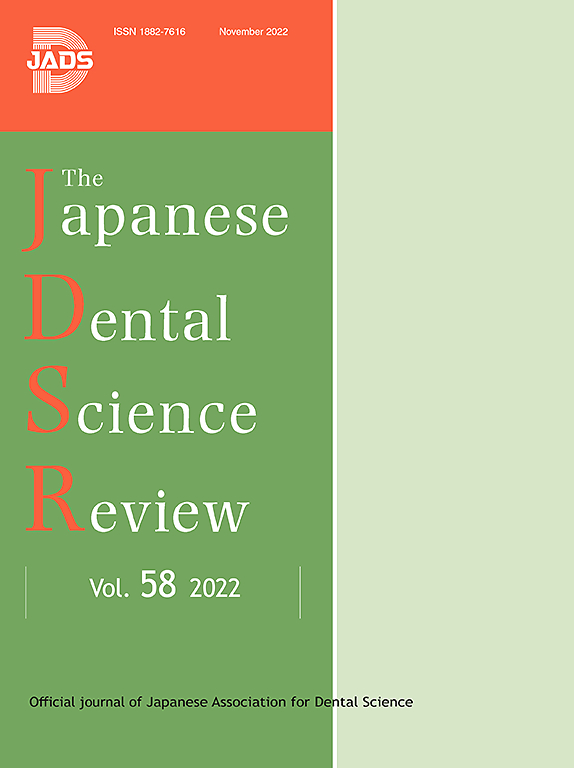Optimizing titanium dioxide-functionalized polymethyl methacrylate (PMMA-TiO₂) for dental applications: A systematic review on physicochemical parameters and antimicrobial outcomes
IF 6.6
2区 医学
Q1 DENTISTRY, ORAL SURGERY & MEDICINE
引用次数: 0
Abstract
Introduction
Polymethyl methacrylate (PMMA) resins are widely used in dental prostheses due to their excellent physical, mechanical, and aesthetic properties. However, their susceptibility to microbial colonization can compromise oral and systemic health. Titanium dioxide (TiO₂), with its photocatalytic activity, has gained attention for its antimicrobial potential. This systematic review investigates how the physicochemical properties of TiO₂ affect its antimicrobial efficacy in PMMA-TiO₂ composites, aiming to optimize their performance and clinical effectiveness.
Methods
PubMed, Embase, Scopus, ScienceDirect, Web of Science, Google Scholar, and ProQuest were searched in October 2024. Articles were selected in two stages by two blinded researchers based on predefined eligibility criteria. Risk of bias was assessed using the RobDEMAT tool.
Results
A comprehensive search identified 1464 articles, which were screened by title and abstract according to inclusion criteria. Of the 28 studies selected for full-text review, 24 were included in this systematic review, all of which were in vitro studies. Due to the high heterogeneity of the selected studies, which prevented statistical analysis of the data, a descriptive analysis was performed.
Conclusions
The balance between concentration, size, crystallinity, and surface morphology can enhance TiO₂ photocatalytic activity and reduce microbial adhesion. Synthesis and functionalization strategies can overcome limitations, expanding the clinical applicability, efficiency, and durability of PMMA-TiO₂ composites.
优化牙科应用的二氧化钛功能化聚甲基丙烯酸甲酯(PMMA-TiO 2):理化参数和抗菌效果的系统综述
聚甲基丙烯酸甲酯(PMMA)树脂因其优异的物理、机械和美学性能而广泛应用于口腔修复中。然而,他们对微生物定植的易感性会损害口腔和全身健康。二氧化钛(TiO 2)具有光催化活性,其抗菌潜力备受关注。本文研究了二氧化钛在pmma -二氧化钛复合材料中的理化性质对其抗菌效果的影响,旨在优化其性能和临床效果。方法于2024年10月检索spubmed、Embase、Scopus、ScienceDirect、Web of Science、谷歌Scholar和ProQuest。两名盲法研究人员根据预先确定的资格标准,分两个阶段选择文章。使用RobDEMAT工具评估偏倚风险。结果综合检索到文献1464篇,根据纳入标准按标题和摘要筛选。在入选全文综述的28项研究中,有24项纳入了本系统综述,均为体外研究。由于所选研究的高度异质性,这阻碍了数据的统计分析,因此进行了描述性分析。结论浓度、粒径、结晶度和表面形貌之间的平衡可以提高tio2光催化活性,减少微生物粘附。合成和功能化策略可以克服局限性,扩大PMMA-TiO 2复合材料的临床适用性,效率和耐久性。
本文章由计算机程序翻译,如有差异,请以英文原文为准。
求助全文
约1分钟内获得全文
求助全文
来源期刊

Japanese Dental Science Review
DENTISTRY, ORAL SURGERY & MEDICINE-
CiteScore
9.90
自引率
1.50%
发文量
31
审稿时长
32 days
期刊介绍:
The Japanese Dental Science Review is published by the Japanese Association for Dental Science aiming to introduce the modern aspects of the dental basic and clinical sciences in Japan, and to share and discuss the update information with foreign researchers and dentists for further development of dentistry. In principle, papers are written and submitted on the invitation of one of the Editors, although the Editors would be glad to receive suggestions. Proposals for review articles should be sent by the authors to one of the Editors by e-mail. All submitted papers are subject to the peer- refereeing process.
 求助内容:
求助内容: 应助结果提醒方式:
应助结果提醒方式:


